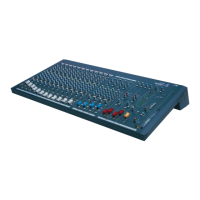
Do you have a question about the SoundCraft Spirit Folio 4 and is the answer not in the manual?
| Brand | SoundCraft |
|---|---|
| Model | Spirit Folio 4 |
| Category | Music Mixer |
| Language | English |
Mixer's XLR input for balanced/unbalanced low-level signals, supports phantom power.
TRS jack inputs for keyboards, synths, tape machines; balanced for low noise.
Jacks for tape playback/recording, effects returns, and main outputs.
Adjusts signal level, prevents distortion and clipping, or avoids excessive hiss.
Filters bass frequencies and shapes tone with HF, MID, LF EQ.
Controls stereo image and pre-fade, post-EQ sends.
Detailed explanation of EQ bands and the EQ switch for tone shaping.
Route signal to aux busses for monitoring or effects.
Controls channel activation, level, pre-fade listening, and output path.
Selects input level (+4/-10) and adjusts stereo EQ (HF & LF).
Pre-fade, post-EQ sends for foldback or monitor feeds.
Bypasses the equaliser section for A/B comparison.
Routes channel signal to auxiliary busses for monitoring or effects.
Controls stereo image, channel activation, and overall signal level.
Pre-fade listening, clipping indication, and output path selection.
Unbalanced inputs for tape playback or effects unit outputs, routable to groups or mix.
Global switch for Aux 3 sends, making them pre or post-fade.
Controls overall aux level and monitors aux outputs.
Sums stereo Aux 7/8 to mono for increased mono send requirement.
Feeds groups post-fade to Aux busses for effects or zone control.
Pairs of outputs for subgroups or controllable outputs, routable to Mix or Aux.
Test tone generator and source selection for monitoring.
Bargraph meters display signal levels for monitoring and overload warning.
Controls final stereo mix output level and stereo image balance.
Sets playback level from tape machines or CD players.
Routes tape return signal to mix or monitor/phones outputs.
Controls output level for monitors and headphones.
Guide for setting input gain levels using PFL and PPM meters for optimal performance.
Setting input level for stereo sources using the +4/-10 switch.
Connecting outputs, building a mix, and managing feedback issues.
Connecting groups to tape inputs, routing signals, and creating monitor mixes.
Using aux sends for musician headphone mixes and connecting effects units.
Using tape sends for live recording, independent of mix fader level.
XLR and TRS jack details, impedance, and phantom power usage.
Adjusts input signal level, preventing clipping or hiss.
Filters out low-frequency rumble and popping sounds.
Breakpoint for external processors like compressors or limiters.
Detailed explanation of EQ bands and the EQ switch for tone shaping.
Routes channel signal to auxiliary busses for monitoring or effects.
Routes channel signal to auxiliary busses for monitoring or effects.
Controls stereo image, output path, and channel activation.
Manages channel level, pre-fade listening, and signal clipping indication.
TRS jack inputs for keyboards, synths, tape machines; balanced for low noise.
Selects input level (+4/-10) and adjusts stereo EQ (HF & LF).
Routes channel signal to auxiliary busses for monitoring or effects.
Post-fade stereo sends for effects and stereo image balance control.
Manages channel activation, level, and pre-fade listening.
Global Aux 3 switch and controls for overall auxiliary send levels.
Unbalanced inputs for tape playback or effects unit outputs, routable to groups or mix.
Pairs of outputs for subgroups or controllable outputs, routable to Mix or Aux.
Main stereo outputs and pre-fade sends for recording.
Displays stereo mix outputs, 2-track returns, groups, or aux levels.
Test tone generator and playback level setting for tape machines.
Routes tape return signal to mix or monitor/phones outputs.
Basic PA setup with microphones, keyboards, and amplifiers.
Driving side fill or centre speakers with aux sends for zoned audio.
Console setup for 2-track or multitrack recording using mix outputs and tape returns.
Console setup for 4-track recording using group outputs and line inputs.
Functions for monitoring pre-fade and post-fade signals.
Definitions for Equaliser, Sweep EQ, and High Pass Filter.
Terms like Line Level, Phantom Power, DI, Balanced, Unbalanced.
Details on noise levels, total harmonic distortion, and crosstalk.
Frequency response characteristics for mic and stereo inputs.
Maximum input and output signal levels.
Electrical impedance values and Common Mode Rejection Ratio.
Physical specifications including unit weight and dimensions.
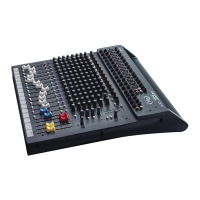
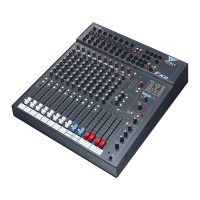
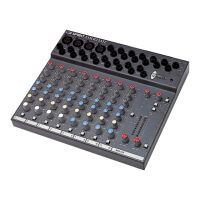
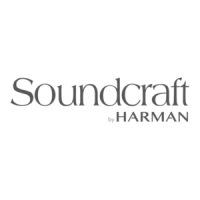

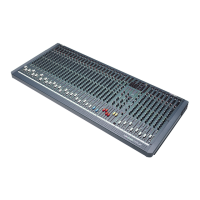
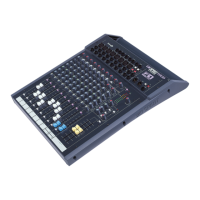
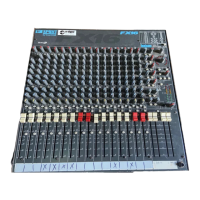
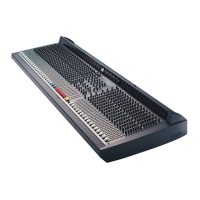

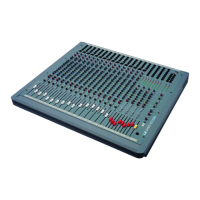
